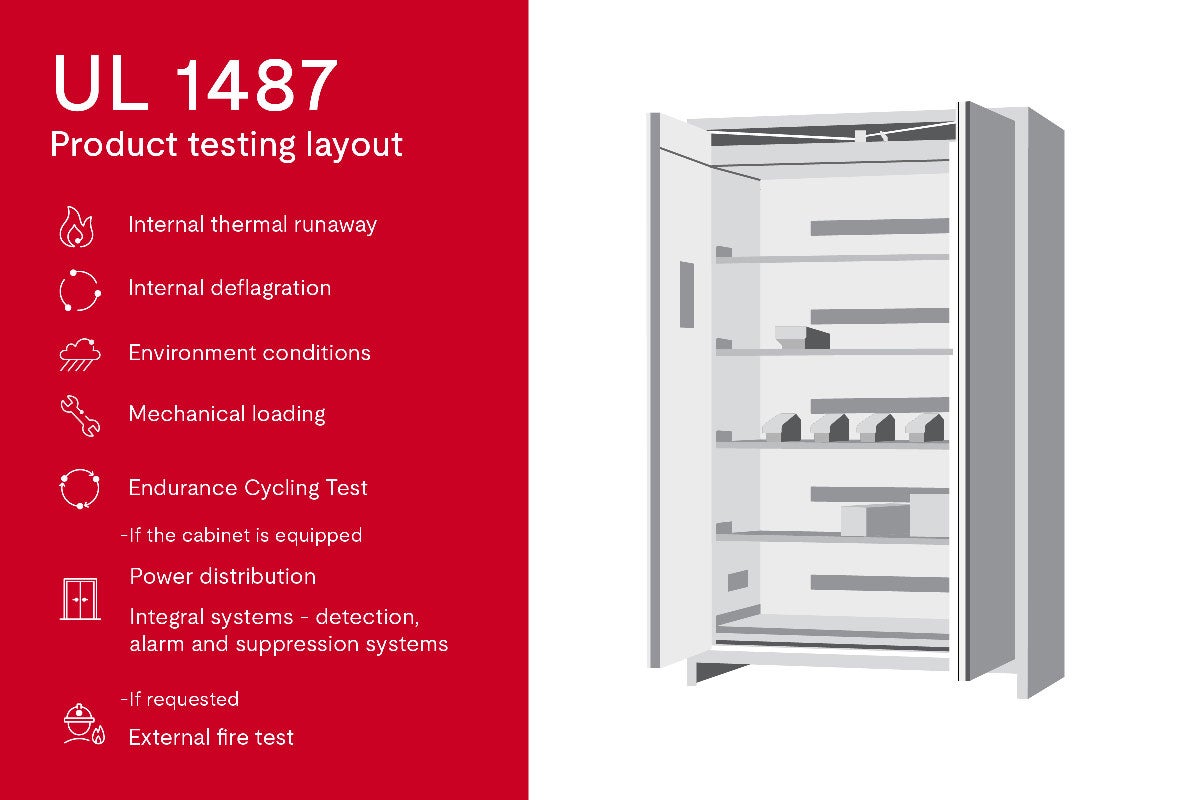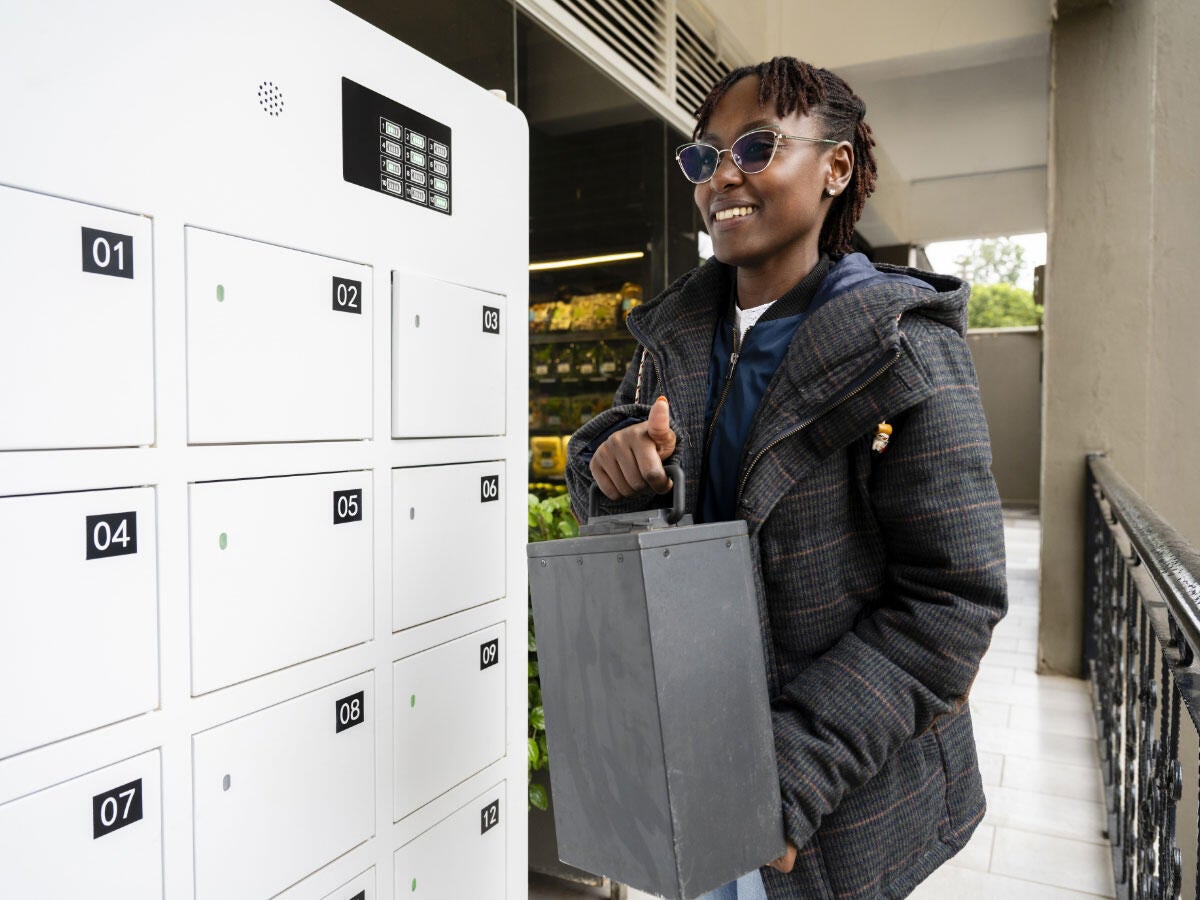
Comprehensive testing and certification for battery containment enclosures (BCEs)
Lithium-ion batteries are present in an increasing variety of popular items but can present serious safety concerns due to fire-related risks known as “thermal runaway.”
UL 1487, the Standard for Battery Containment Enclosures, defines a BCE as “a product that encloses and stores lithium-ion cells, batteries, battery packs and battery-powered devices, and is intended to help mitigate the heat, fire and deflagration hazards generated by lithium-ion battery thermal runaway.”
UL 1487 is the first standard to establish safety performance requirements for BCEs through independent testing, with emphasis on thermal runaway risk mitigation, and will become a global regulation by 2027.
Understanding UL 1487
Lithium-ion batteries provide power for an increasing variety of popular items — including scooters, e-bikes, lawn mowers, power tools and more — but they come with safety concerns that make proper enclosure design critically important.
Lithium-ion batteries can experience a phenomenon known as “thermal runaway,” which can produce jet-like flames that erupt from the battery during storage and charging cycles.
Why does this happen?
- Heat buildup: When a battery is damaged, overcharged or has a defect, it can start to generate more heat than it can release.
- Chemical reactions: The heat causes chemical reactions inside the battery, which produce even more heat.
- Uncontrollable cycle: This extra heat speeds up the reactions, creating a cycle that makes the battery hotter and hotter.
Why is it dangerous?
If the battery gets too hot, it can catch fire, explode or release harmful gases.
Thermal runaway can result in:
- Ejection of gas, shrapnel and/or particulates (violent cell venting).
- Extremely high temperatures.
- Flammable and toxic gases.
When thermal runaway occurs, the lithium-ion cell generates heat several times faster than the rate at which the heat is dissipating from the cell. The cell reaches thermal runaway when its temperature rises uncontrollably at a rate greater than 20° centigrade per minute, with maximum temperatures reaching greater than 300°C accompanied by gas and/or electrolyte venting, smoke or fire — or all of the above.
A BCE, then, must be able to help shield a product from these potential dangers. Current safety standards do not address lithium-ion battery risks when the products are stored or charged in a BCE.
UL 1487 provides critical testing assessments for BCEs
UL 1487 establishes safety performance requirements through comprehensive construction and testing standards, with an emphasis on thermal runaway risk mitigation.
UL 1487, which currently excludes products intended for residential applications, is proposed for reference in the 2027 International Fire Code (IFC). If approved through the code development process, it will be a model fire code requirement available for jurisdiction adoption and will enable manufacturers to meet future National Fire Protection Agency (NFPA) 1 fire code requirements for BCE.
UL 1487 can bring many benefits for manufacturers, including:
- Providing confidence that their BCEs can effectively mitigate the risks of lithium battery thermal runaway events.
- Enhancing market acceptance due to increased confidence that the BCE has been tested and certified by UL Solutions, a global safety science leader.
- Demonstrating compliance with relevant safety requirements.
- Satisfying insurance provider requirements.
UL 1487 implements the following test methodologies:
- Internal thermal runaway test – Utilizes standardized lithium-ion battery packages deliberately induced into thermal runaway within the product. Test sizing is determined by the storage cavity energy containment rating.
- Internal deflagration test – Subjects the product to ignition of standardized flammable mixtures, simulating explosive ignition of thermal runaway effluent gases. Performance criteria evaluate the product’s ability to maintain structural integrity while containing fire, explosion and thermal hazards.
Additional assessment areas include:
- Internal electrical power distribution.
- Integral systems: detection, alarm and suppression systems.
- Environmental exposure resilience.
- Mechanical load capabilities.
External fire test (optional):
- This test evaluates the time period in which BCE can prevent an external fire from entering BCE and involving BCE contents (batteries).
- A typical assessment method requires occupancy separation.

Finding products certified to UL 1487
BCEs certified by UL Solutions to UL 1487 can be found in the online certification directory, UL Product iQ®. This directory is available at no cost but requires a one-time registration.
- UL 1487 differs from UL 5800, the Standard for Safety for Battery Fire Containment Products. UL 5800 certifies fire containment devices to mitigate the risk of thermal runaway of a battery powered portable electronic device in the cabin of an airplane.
- UL 1487 differs from UL 4900, the Standard for Safety of Micromobility Charging Equipment. UL 4900 is focused on the equipment that provides charging for e-bikes and scooters. UL 4900 addresses the electric shock and fire risks of the charging infrastructure.
- UL 1487 differs from other standards, which are technically testing methodologies and not certification methodologies. The former doesn’t provide certification, and it also doesn’t address the gas or explosion hazards that can be created by thermal runaways. Therefore, UL 1487 doesn’t provide a full product assessment.
Get connected with our sales team
Contact us to learn more about UL 1487 certification for BCEs.



